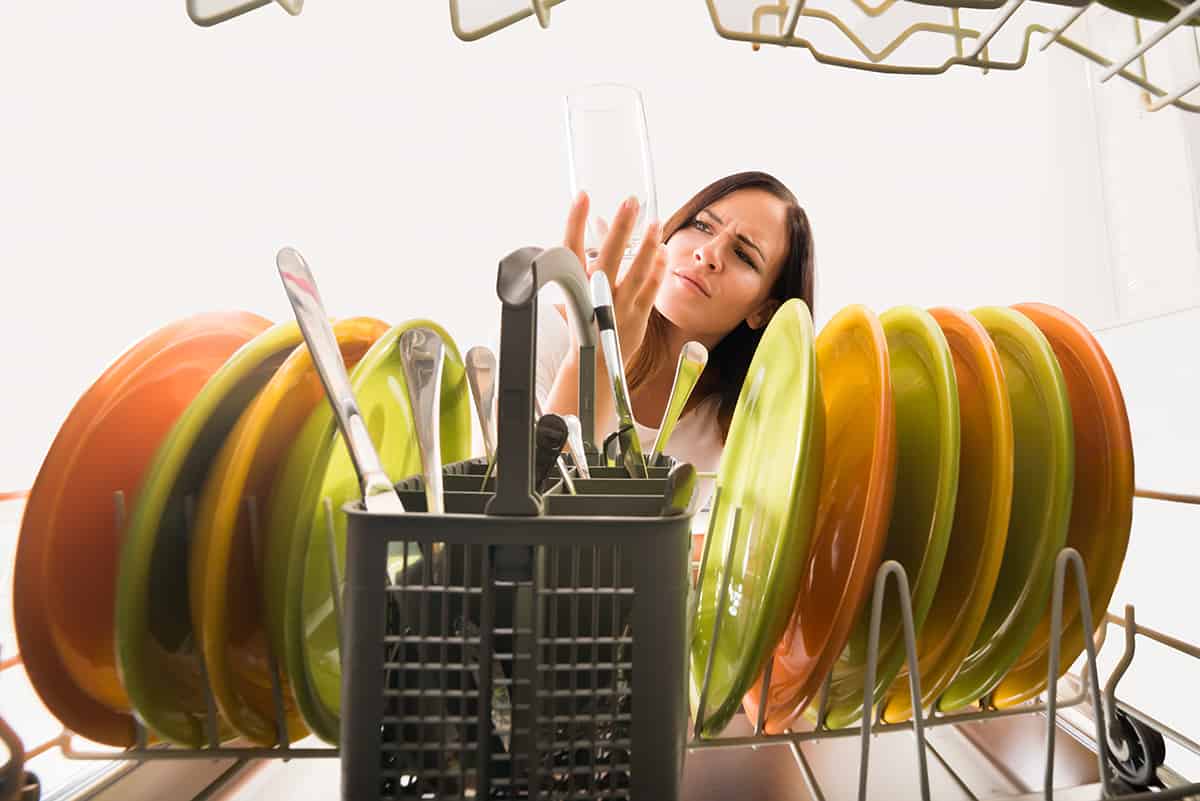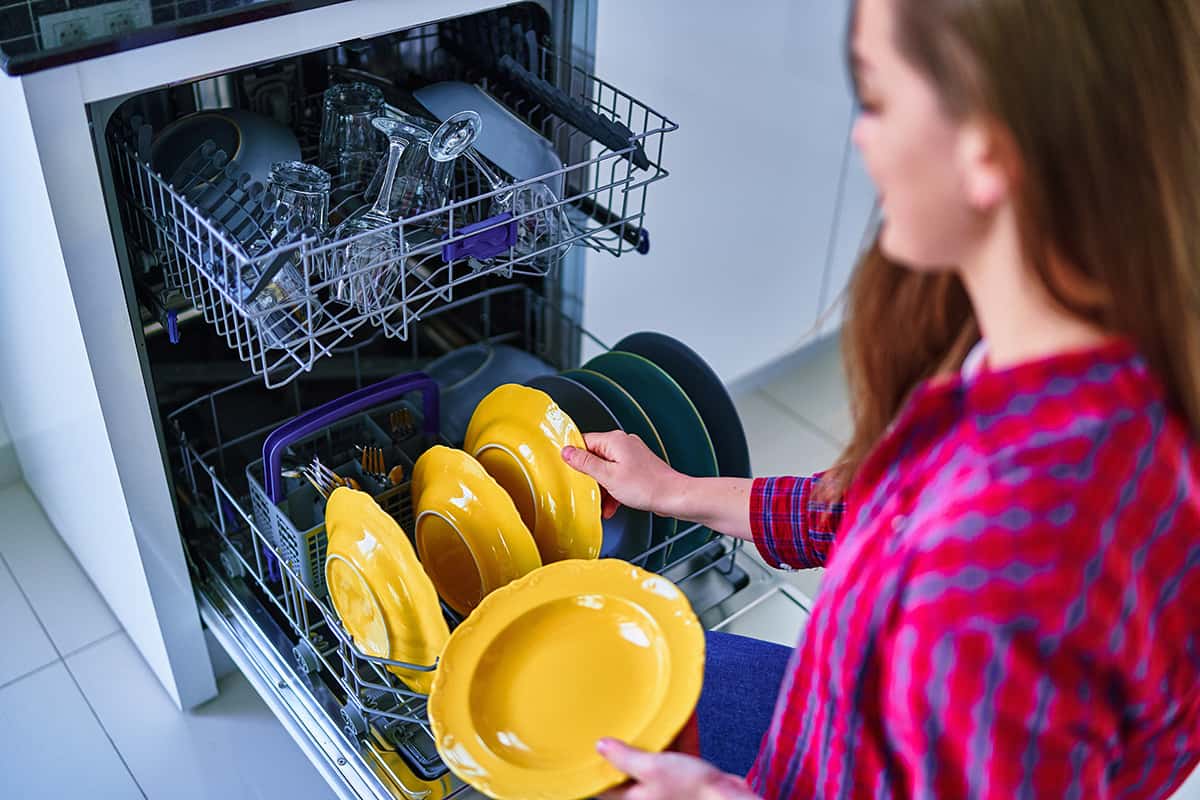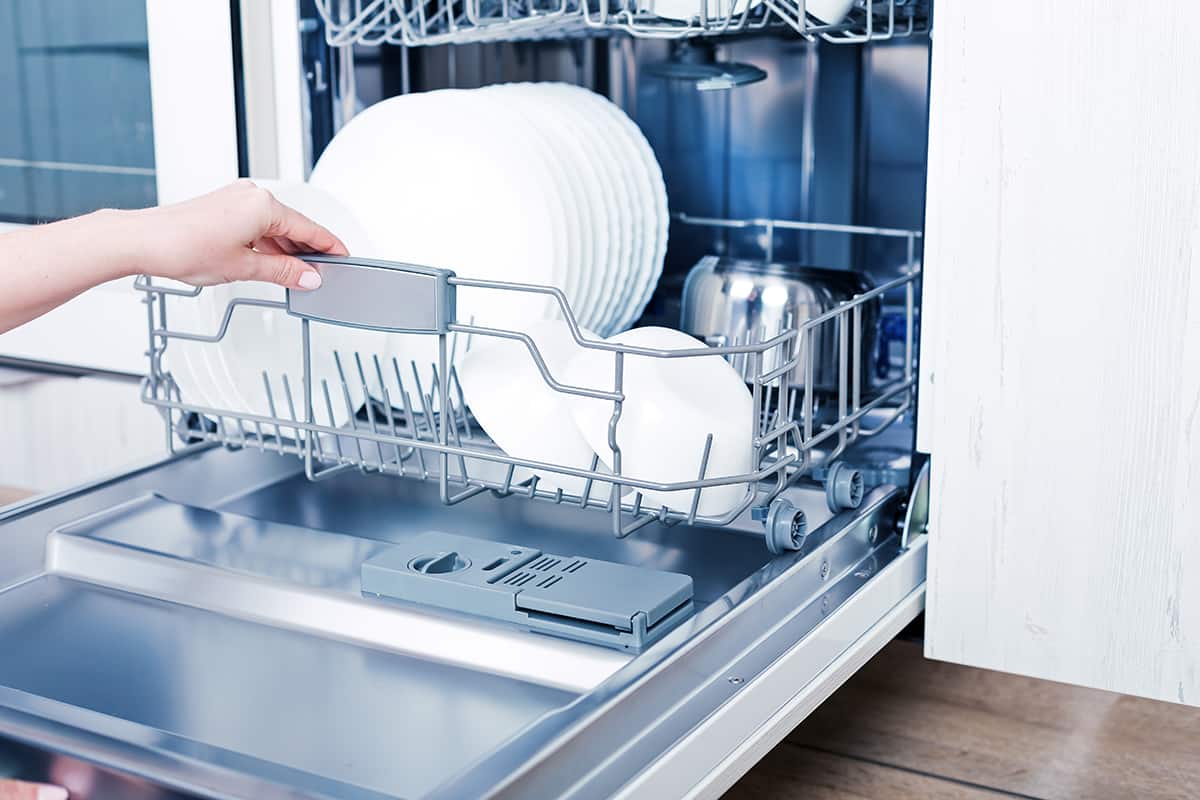Have you ever opened discovered dirty plates in the top rack of your dishwasher after a complete wash cycle? You’re not alone since it’s a lot more common than you might think. So, what causes dishes on the top rack to remain unclean?
If the dishes in the top rack of your dishwasher aren’t clean, the most common cause is low water pressure. The problem might be caused by running multiple appliances at once, a kick or tear in the water supply hose, a broken spray arm seal, or blockages in the spray arm.
In this guide, I’ll explain in greater detail the common causes of your dishwasher not cleaning the top rack and how to resolve the problem.
Common Causes of Dishwasher Not Cleaning the Top Rack (And How to Fix Them)

If your dishwasher fails to clean the dishes in the top dishrack, the most likely culprit is that your machine isn’t receiving enough water pressure. The spray arm relies on high-pressure jets to rotate and spray water upward. If it isn’t getting the right volume of water at the right pressure, the spray won’t reach the top dishrack.
Now, let’s take a look at the various causes of low water pressure in your dishwasher.
Improperly Positioned Top Rack
The top rack needs to be pushed entirely inside the dishwasher to work perfectly. If the dishrack is slightly out of position, the spray arm might not be able to reach all of the nooks and crannies, thereby leaving your dishes unclean even after a full wash cycle.
Solution: Push the dishrack inside the dishwasher before shutting the door
Usually, the dishwasher’s door will push any improperly positioned racks into place. However, it won’t hurt to give this solution a try, especially since it’s so easy to implement. Make sure none of the dishes in the top rack are jutting out from the bottom of the rack.
Running Multiple Appliances at Once
Your toilet, shower, washing machine, faucets, and many other appliances and fixtures rely on a constant stream of water to operate. Where you live, you might receive 6 to 10 gallons of water every minute from your home’s water supply line. While that might be a lot, it’s not enough to supply water to numerous water-dependent appliances at the same time.
Solution: Turn off all other water-dependent appliances
Before turning your dishwasher on, make sure other appliances that use water are turned off. Make sure nobody is taking a shower in the bathroom or that your pool’s pump is switched off.
Damaged Water Supply Hose
Your dishwasher will most likely be connected to your home’s hot water supply line. That way, the dishwasher’s heating element doesn’t have to work overtime to raise the temperature of water to a sanitizing level. However, if the water supply hose to your dishwasher is damaged in any way, it could result in a significant loss of pressure.
Solution #1: Inspect the water supply hose for kinks or tears
To do this, you will have to shut off your dishwasher and disconnect it from the wall outlet. You will have to shut off the electrical power supply to your dishwasher if it’s hardwired. After that, carefully pull the dishwasher out of position to inspect the water supply valve. If the hose has kinks or tears, it could be the cause of why there isn’t enough water pressure entering the dishwasher. Undo the kinks or replace the water supply hose if it’s torn.
Solution #2: Inspect your hot water tank
Your hot water tank might not be heating enough water quickly enough for the dishwasher to use, thereby limiting how much it receives. This could be a result of running multiple appliances at once or a buildup of sediment in your hot water tank. You’ll most see signs of this problem from other sources of water in your home, like hot water faucets.
Blocked Water Inlet Filter
Newer dishwasher models come with a tiny filter that sits between the inlet hose and your kitchen’s water supply line. The filter is in place to capture larger bits of debris that are common in hard water—water with high concentrations of mineral residue. Over time, the water inlet filter might become clogged with solid debris, reducing water pressure to the machine.
Solution: Clean the water inlet filter
Before you get started, shut off the water supply line to your kitchen or to your entire home. That way, when you disconnect the water inlet hose, water won’t spray all over you and your kitchen floor.
After doing that, remove the dishwasher’s inlet hose from the water supply line and inspect it for blockages. You can dunk the filter in a bucket of soapy water and let it sit for 15 minutes before carefully scrubbing away the debris and reinstalling it in the inlet hose. Turn your water supply line back on and run a test rinse cycle.
Broken Spray Arm Seal
Underneath the top rack of your dishwasher is a spray arm that rotates and shoots water upward to clean the dishes in the top dishrack. If you take the spray arm apart, you’ll find an O-seal that keeps water from trickling out of the connection between the spray arm’s supply line and the rotating arm. If the seal is damaged, it could result in low water pressure.
Solution: Replace the seal
To replace the seal of your dishwasher’s spray arm, you will first have to remove the top dishrack. Place it on a flat work surface and flip it over to access the spray arm. Disconnect the supply pipe to the rotating arm by removing the screw. Now, remove the spray arm and discard the damaged O-seal. Finally, reinstall the spray arm’s supply hose and place it back in your dishwasher before running a test cycle.
Clogs in the Spray Arm
The spray arm has multiple tiny holes where jets of water spray out to clean your dishes. While the top dishrack is reserved for cutlery and glasses, it’s not uncommon for the upper spray arm to catch solid bits of debris. If the debris and dishwasher residues somehow land in a hole, it can prevent it from spraying enough water to clean the dishes on the top dishrack.
Solution #1: Clean the holes with a toothpick
You’ll need a narrow object, such as a toothpick, to unblock the holes. To gain easier access to the spray arm, remove it from the dishwasher as you would when fixing a broken seal. Now, carefully inspect the surface of the spray arm and poke all of the holes to dislodge any solid bits of debris. After doing so on all of the holes, reinstall the top dishrack in your dishwasher and run a test rinse cycle.
Solution #2: Soak the spray arm
You can remove the spray arm entirely by removing it from the center hub. Fill a large basic with soapy water and dunk the spray arm in it, leaving it there for 30 minutes. The soapy solution will get inside the spray arm, loosening any bits of debris that might be in there. Rinse the spray arm with clean water before reinstalling it.
Damaged Circulation Pump
The circulation pump’s job is to force pressurized water through the spray arm. Over thousands of wash cycles, the circulation pump might fail, and the dishwasher might not recognize the issue. One clear sign that the circulation pump is on the fritz is loud bumping noises coming from the dishwasher.
Solution: Replace the circulation pump
Sadly, there’s not much you can do here apart from replacing the circulation pump. You can try removing it from the dishwasher by removing the back panel and testing it with a multimeter for continuity.
However, if that fails, you will have to pick up a replacement pump and install it in your dishwasher. For those that aren’t handy around electronic components, consider hiring the help of a professional repairman.
Dishes on the Top Rack Are Only Partially Cleaned

If the dishes on the top dishrack are only partially cleaned or are streaky, you’re in luck—the problem with your dishwasher isn’t a technical one. The most likely culprit behind streaky or partially cleaned dishes is improperly loading the machine or using too much detergent.
Loading the top dishrack isn’t too difficult, but it’s also pretty easy to do it incorrectly. To properly load your dishwasher, use the dulled upward-facing rods as guides on where to place your dishes.
In the top dishrack, limit one rod per glass. If you’re washing wider objects in the dishrack, make sure you leave several inches of clearance on all of its sides to prevent its debris from contaminating adjacent objects.
If your dishes turn out streaky, try reducing how much dishwasher detergent you use. The detergent dispenser works as a guide to inform the user how much detergent to add. If it overflows, you’re using too much, and your dishwasher may have trouble removing excess soapy residue.
Also, consider using a rinse aid in your dishwasher to help get rid of streaks and to dry your dishes more quickly. If you’re not opposed to them, give dishwasher pods or tablets a try. They oftentimes come with multiple soaps to aid in both washing and rinsing your dishes.






